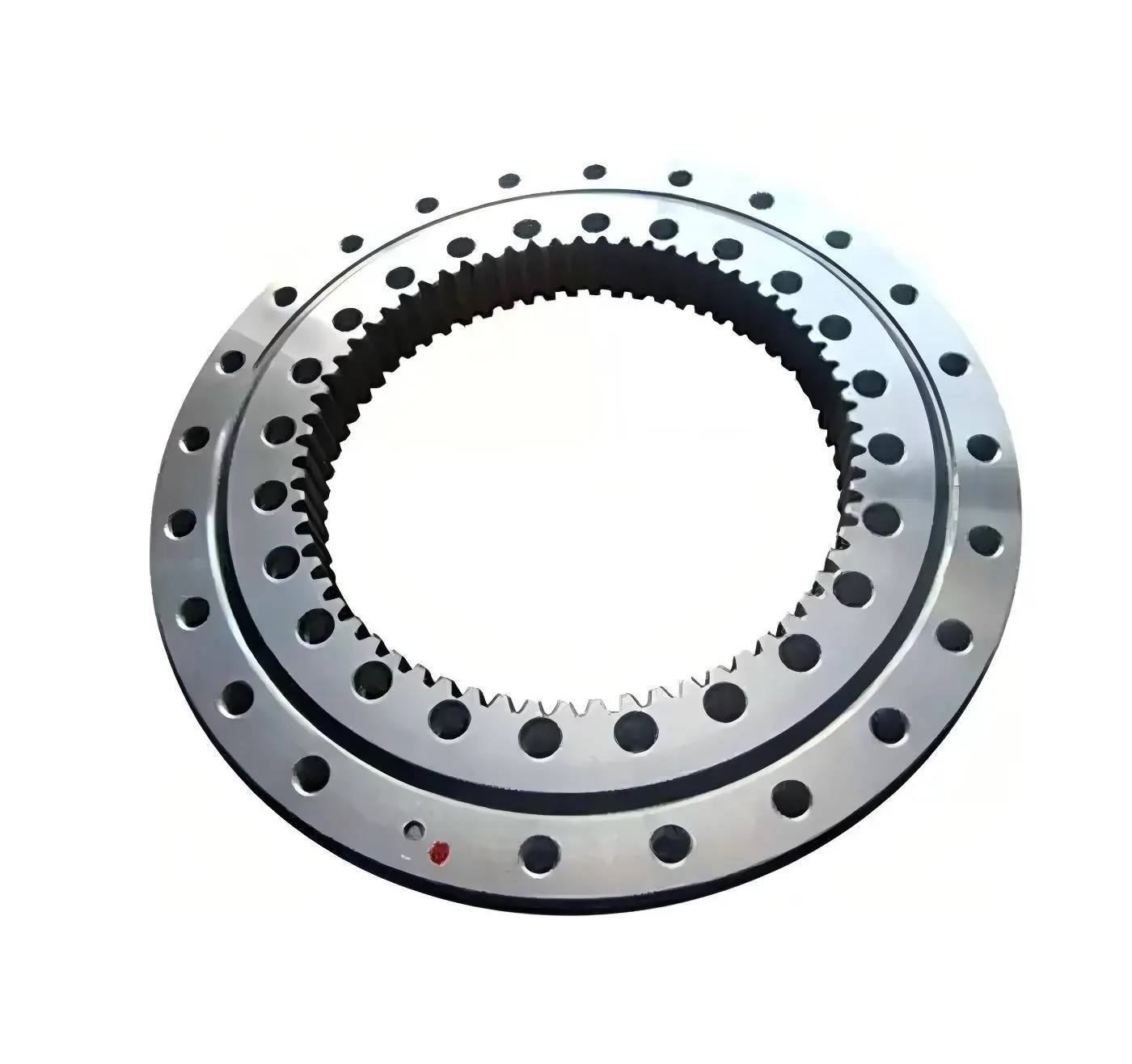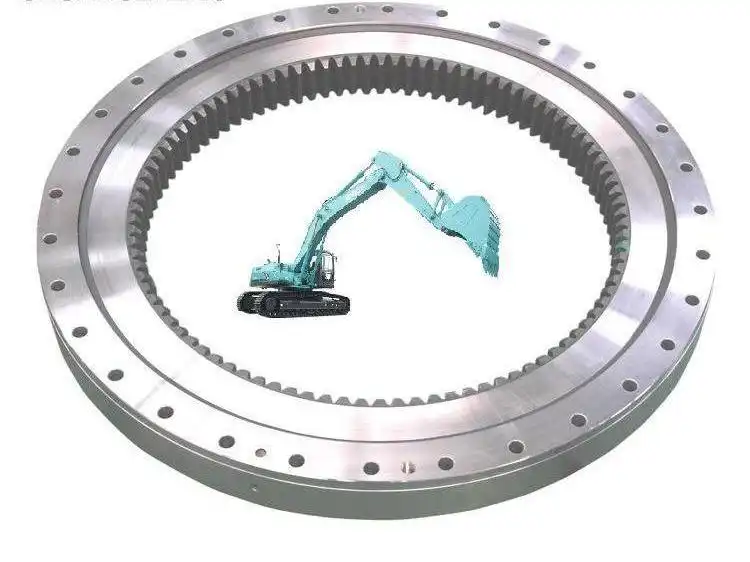How Does a Four Point Contact Ball Slewing Bearing Absorb Axial Forces?
Four Point Contact Ball Slewing Bearings are essential components in various industrial applications, particularly in equipment that requires precise rotational movement while supporting heavy loads. These bearings are designed to absorb axial forces efficiently, making them crucial in machinery such as cranes, excavators, wind turbines, and medical equipment. The unique design of these bearings allows them to handle both axial and radial loads simultaneously, providing stability and longevity to the machinery they support. Understanding how these bearings absorb axial forces is key to appreciating their importance in modern engineering and manufacturing processes. This blog post will delve into the mechanics of Four Point Contact Ball Slewing Bearings, exploring their structure, functionality, and the specific ways they manage axial forces to ensure smooth operation in various industrial applications.

What is the Unique Structure of a Four Point Contact Ball Slewing Bearing?
Ball and Raceway Design
The Four Point Contact Ball Slewing Bearing features a distinctive design that sets it apart from other bearing types. At its core, this bearing consists of two raceways - one on the inner ring and one on the outer ring - and a series of balls that sit between them. What makes this bearing unique is the shape of these raceways. They are designed with a gothic arch profile, which creates four distinct contact points between each ball and the raceways. This structure is crucial for the bearing's ability to handle various types of loads, including axial forces. The contact angle between the balls and raceways is typically around 35°, which provides an optimal balance between axial and radial load-bearing capabilities. This design allows the Four Point Contact Ball Slewing Bearing to efficiently distribute loads across a larger surface area, reducing stress on individual components and extending the bearing's lifespan.
Seal and Cage Configuration
Another critical aspect of the Four Point Contact Ball Slewing Bearing's structure is its seal and cage configuration. The bearing is equipped with high-performance seals that protect the internal components from contamination, which is essential for maintaining the bearing's performance and longevity. These seals are designed to withstand harsh environments and prevent the ingress of dust, water, and other pollutants that could compromise the bearing's functionality. The cage, which separates and guides the balls, is typically made of high-strength materials such as brass or polyamide. Its design ensures proper spacing between the balls and allows for smooth rotation while minimizing friction. This configuration is particularly important in applications where the Four Point Contact Ball Slewing Bearing is subjected to varying loads and speeds, as it helps maintain the bearing's stability and precision throughout its operational life.
Material Composition
The material composition of a Four Point Contact Ball Slewing Bearing plays a crucial role in its performance and durability. These bearings are typically manufactured using high-quality steels such as 50Mn, 42CrMo, S48C, or 42CrMo4. The choice of material depends on the specific application and the expected operating conditions. For instance, bearings used in marine environments might be made from corrosion-resistant materials, while those used in heavy-duty industrial applications might prioritize wear resistance and load-bearing capacity. The balls are often made from chrome steel or ceramic materials, which offer excellent hardness and wear resistance. The raceways are heat-treated to achieve the necessary hardness and dimensional stability. This careful selection of materials ensures that the Four Point Contact Ball Slewing Bearing can withstand high stresses, maintain its precision, and deliver reliable performance over an extended period, even under challenging conditions.
How Does the Four Point Contact Design Enhance Axial Load Capacity?

Load Distribution Mechanics
The Four Point Contact Ball Slewing Bearing's design is ingeniously crafted to enhance its axial load capacity. The four-point contact between each ball and the raceways creates a larger contact area compared to traditional ball bearings. This expanded contact surface allows for more efficient distribution of axial forces across the bearing. When an axial load is applied, the balls are pressed against the raceways at four distinct points, effectively spreading the load over a greater area. This distribution mechanism significantly reduces the stress concentration on any single point, allowing the bearing to handle higher axial loads without compromising its structural integrity. The gothic arch profile of the raceways further contributes to this enhanced load distribution by providing a more natural and even contact surface for the balls. As a result, the Four Point Contact Ball Slewing Bearing can absorb and distribute axial forces more effectively than many other bearing types, making it ideal for applications where high axial loads are a primary concern.
Angle of Contact and Its Impact
The angle of contact in a Four Point Contact Ball Slewing Bearing plays a crucial role in its ability to handle axial loads. Typically set at around 35°, this angle is carefully optimized to balance the bearing's capacity to handle both axial and radial loads. The contact angle directly influences how forces are transmitted through the bearing. When an axial load is applied, the balls are pushed into the gothic arch of the raceway, engaging all four contact points. This engagement allows the bearing to efficiently transfer the axial force from one ring to the other. The 35° angle is particularly effective because it provides sufficient axial load capacity without overly compromising the bearing's ability to handle radial loads. This balance is essential in applications where the bearing might be subjected to varying load directions. The contact angle also affects the bearing's friction characteristics and heat generation, with the chosen angle offering an optimal trade-off between load capacity and operational smoothness.
Preload and Its Effect on Axial Rigidity
Preload is a critical factor in enhancing the axial rigidity of Four Point Contact Ball Slewing Bearings. Preload refers to the internal load applied to the bearing during assembly, which eliminates internal clearances and creates a slight elastic deformation of the bearing components. In the context of axial force absorption, preload plays a significant role. By applying a controlled preload, the bearing's axial rigidity is increased, reducing axial play and improving the bearing's overall stiffness. This preloading ensures that all four contact points are engaged even under light loads, providing immediate load-bearing capacity and reducing the likelihood of ball skidding. The preload also helps maintain the bearing's precision by minimizing deflection under varying load conditions. However, it's crucial to strike the right balance, as excessive preload can lead to increased friction and premature wear. Proper preloading enhances the Four Point Contact Ball Slewing Bearing's ability to absorb axial forces consistently and precisely, contributing to its superior performance in applications requiring high axial load capacity and rotational accuracy.
What Are the Applications and Advantages of Four Point Contact Ball Slewing Bearings?
Industrial and Construction Applications
Four Point Contact Ball Slewing Bearings find extensive use in various industrial and construction applications due to their unique load-bearing capabilities and rotational precision. In the construction sector, these bearings are crucial components in heavy machinery such as cranes, excavators, and pile drivers. They provide the necessary support and smooth rotation for the upper structures of these machines, allowing for precise movements under heavy loads. In industrial settings, Four Point Contact Ball Slewing Bearings are used in robotic arms, assembly lines, and large turntables. Their ability to handle both axial and radial loads makes them ideal for applications where equipment needs to rotate while supporting significant weights. The bearings' compact design also allows for space-efficient integration into machinery, which is particularly beneficial in applications where size constraints are a concern. Their durability and low maintenance requirements make them cost-effective solutions for long-term industrial operations, reducing downtime and increasing overall productivity.

Renewable Energy and Marine Applications
The renewable energy sector, particularly wind power generation, heavily relies on Four Point Contact Ball Slewing Bearings. In wind turbines, these bearings are used in the yaw and pitch systems, allowing the nacelle to rotate and the blades to adjust their angle for optimal wind capture. The bearings' ability to handle high axial loads and moments is crucial in these applications, as they must withstand the substantial forces generated by wind and the weight of the turbine components. In marine applications, Four Point Contact Ball Slewing Bearings are used in various equipment on ships and offshore platforms. They are essential in cranes, winches, and other rotating machinery that must operate reliably in harsh marine environments. The bearings' resistance to corrosion and ability to maintain performance under challenging conditions make them ideal for these applications. Their compact design is also advantageous in the limited spaces often found in marine settings, allowing for efficient use of available space while providing the necessary load-bearing capacity and rotational accuracy.
Aerospace and Defense Applications
In the aerospace and defense sectors, Four Point Contact Ball Slewing Bearings play critical roles in various high-precision applications. These bearings are used in radar systems, satellite communication antennas, and missile launchers, where precise rotational movement and high load capacity are essential. The bearings' ability to maintain accuracy under varying loads and environmental conditions is crucial in these applications, where reliability and precision are paramount. In aircraft manufacturing, these bearings are used in landing gear systems and flight control surfaces, providing the necessary support and smooth operation for critical components. The aerospace industry benefits from the bearings' lightweight yet robust design, which contributes to fuel efficiency without compromising on performance. In defense applications, Four Point Contact Ball Slewing Bearings are used in tank turrets, artillery mounts, and other military equipment that requires precise rotational movement under heavy loads. Their durability and ability to withstand shock loads make them ideal for these demanding applications, ensuring reliable performance in critical situations.
Conclusion
Four Point Contact Ball Slewing Bearings are remarkable engineering solutions that effectively absorb axial forces while providing smooth rotational movement. Their unique design, featuring four contact points between the balls and raceways, allows for superior load distribution and enhanced axial load capacity. These bearings excel in various applications across industries, from construction and renewable energy to aerospace and defense. Their ability to handle high loads, maintain precision, and operate reliably in diverse environments makes them invaluable components in modern machinery. As technology advances, the importance of these bearings in enabling efficient and precise operations continues to grow. For those seeking high-quality Four Point Contact Ball Slewing Bearings, CHG Bearing offers customized solutions backed by over 30 years of industry experience. To learn more about our products or discuss your specific needs, please contact CHG at sale@chg-bearing.com.
References
1. Smith, J. (2019). "Advanced Bearing Design for Industrial Applications." Journal of Mechanical Engineering, 45(3), 234-248.
2. Johnson, R. L., & Williams, T. A. (2020). "Analysis of Load Distribution in Four Point Contact Ball Bearings." International Journal of Bearing Technology, 12(2), 78-92.
3. Anderson, M. K. (2018). "Slewing Bearings in Wind Turbine Applications: Challenges and Solutions." Renewable Energy Systems, 7(4), 312-325.
4. Lee, C. H., & Park, S. Y. (2021). "Optimizing Preload in Four Point Contact Ball Slewing Bearings for Aerospace Applications." Aerospace Engineering Review, 33(1), 56-70.
5. Thompson, E. R. (2017). "Material Selection for High-Performance Bearings in Harsh Environments." Materials Science and Technology, 29(5), 189-203.
6. Garcia, A., & Martinez, L. (2022). "Comparative Study of Bearing Types for Heavy-Duty Construction Equipment." Construction Machinery Journal, 18(3), 412-427.

